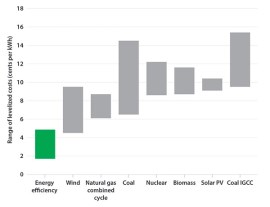by Brianna Crandall — April 2, 2014—According to a report just released by the American Council for an Energy-Efficient Economy (ACEEE), energy efficiency is the cheapest method of providing Americans with electricity. Energy efficiency programs aimed at reducing energy waste cost utilities only about three cents per kilowatt hour, while generating the same amount of electricity from sources such as fossil fuels can cost two to three times more.
“The cheapest energy is the energy you don’t have to produce in the first place,” said ACEEE Executive Director Steven Nadel. “Our new report shows that when utilities are examining options on how to provide their customers with cheap, clean electricity, energy efficiency is generally the best choice.”
“Why build more expensive power plants when efficiency gives you more bang for your buck?” said Maggie Molina, utilities, state and local program director and author of the report. “Investing in energy efficiency helps utilities and ratepayers avoid the expense of building new power plants and the harmful pollution that plants emit.”

Levelized costs of electricity resource options. Source: Energy efficiency data represent the results of this analysis for utility program costs (range of four-year averages for 2009-2012); supply costs are from Lazard 2013.
(Click on image to enlarge)
The report, The Best Value for America’s Energy Dollar: A National Review of the Cost of Utility Energy Efficiency Programs, looks at the cost of running efficiency programs in 20 states from 2009 to 2012, and finds an average cost of 2.8 cents per kilowatt-hour (kWh)—about one-half to one-third the cost of alternative new electricity resource options, as illustrated by the graph on this page.
The report analyzes energy efficiency costs from states across the country, including: Arizona, California, Colorado, Connecticut, Hawaii, Illinois, Iowa, Massachusetts, Michigan, Minnesota, New Mexico, New York, Nevada, Oregon, Pennsylvania, Rhode Island, Texas, Utah, Vermont and Wisconsin.
Other key findings include:
- At an average of 35 cents per therm, natural gas utility energy efficiency programs are also highly cost-effective. (In 2013, the national average natural gas commodity price was 49 cents per therm.)
- Both electricity and natural gas efficiency programs have consistently remained low-cost resources over the past decade, which shows the reliability of efficiency as a long-term resource.
- Each dollar invested in electric energy efficiency measures yields $1.24 to $4.00 in total benefits for all customers, which include avoided energy and capacity costs, lower energy costs during peak demand periods like heat waves, avoided costs from building new power lines, and reduced pollution.
- Incorporating higher levels of energy efficiency in long-term planning can protect utilities and their customers against volatile and rising costs of traditional energy resources.
The Best Value for America’s Energy Dollar: A National Review of the Cost of Utility Energy Efficiency Programs is available for free download from the ACEEE Web site.





